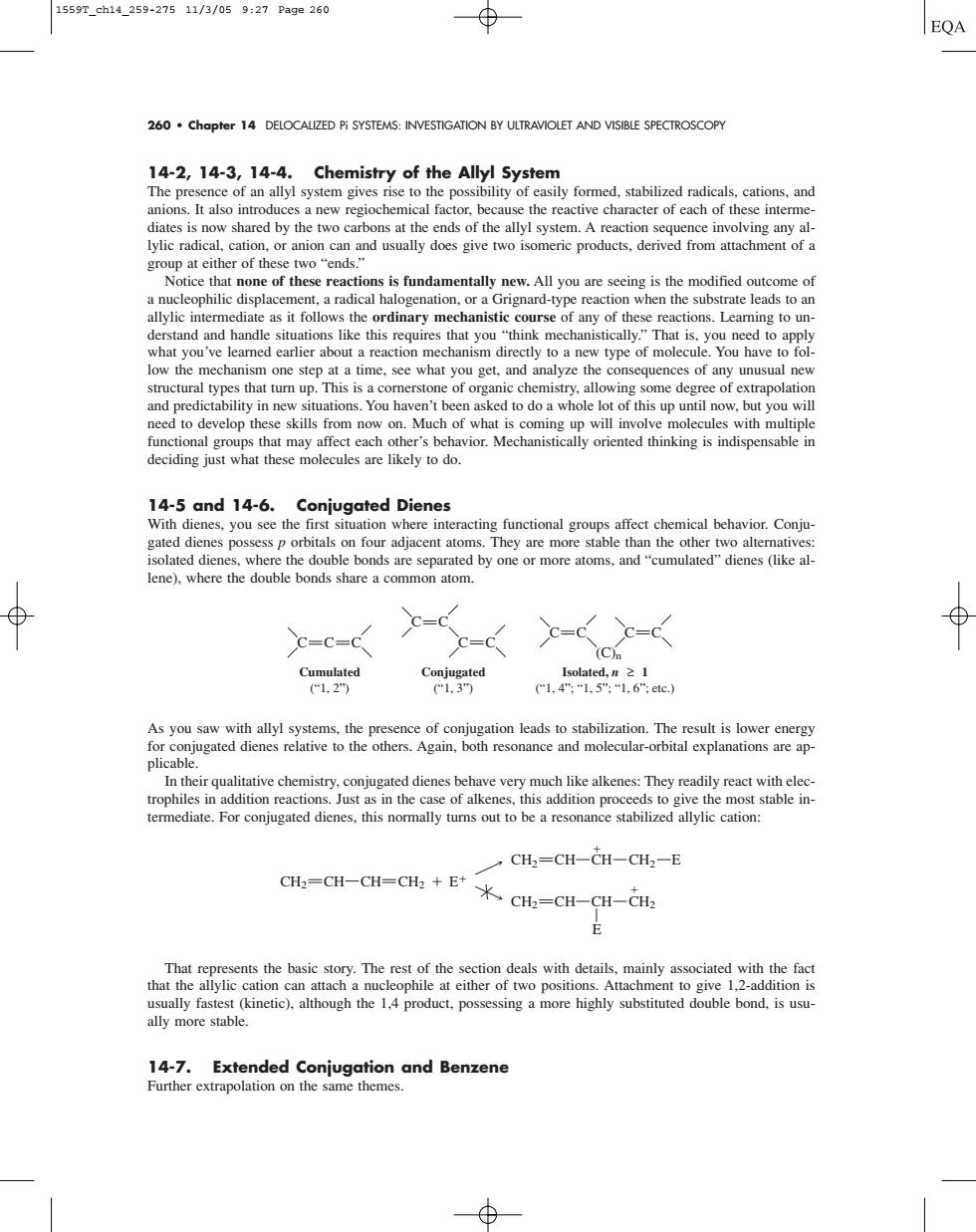正在加载图片...

1559rch14259-27511/3/059:27Pag0260 EQA 260 chapter 14 DELOCALIZED Pi SYSTEMS:INVESTIGATON BY ULTRAVIOLET AND VISIBLE SPECTROSCOPY 14-2,14-3,14-4 Chemistry of the Allyl System diates is now shared by the two carbons at the ends of the allyl system.A reaction sequence involving any al ylic radic usually does give two isomeric products.derive d from attachment of a ognonraGrigard-type what you've leamed earlier about a reaction mechanism directly to a ne that tum up.This is a comerstone of orsanis chemis and predictab bility in ne tuations.You haven't been asked to doa whole lot of this up until now,but you wil skills from now on. deciding just what these molecules are likely to do. Va-s and 6. Conju see the Donds are separate C=C C=C C==c co. C1.45“16ce ns are ap In thei r qualitative chemistry,conjugated dienes be CH2=CH-CH-CH2-E CH:-CH-CH-CH+ECH:-CH-CH-C E usually fastest(kinetic).touh the 1,4 product.highly substituted double bond,isusu ally more stable 14-7.Extended Conjugation and Benzene Further extrapolation on the same themes260 • Chapter 14 DELOCALIZED Pi SYSTEMS: INVESTIGATION BY ULTRAVIOLET AND VISIBLE SPECTROSCOPY 14-2, 14-3, 14-4. Chemistry of the Allyl System The presence of an allyl system gives rise to the possibility of easily formed, stabilized radicals, cations, and anions. It also introduces a new regiochemical factor, because the reactive character of each of these intermediates is now shared by the two carbons at the ends of the allyl system. A reaction sequence involving any allylic radical, cation, or anion can and usually does give two isomeric products, derived from attachment of a group at either of these two “ends.” Notice that none of these reactions is fundamentally new. All you are seeing is the modified outcome of a nucleophilic displacement, a radical halogenation, or a Grignard-type reaction when the substrate leads to an allylic intermediate as it follows the ordinary mechanistic course of any of these reactions. Learning to understand and handle situations like this requires that you “think mechanistically.” That is, you need to apply what you’ve learned earlier about a reaction mechanism directly to a new type of molecule. You have to follow the mechanism one step at a time, see what you get, and analyze the consequences of any unusual new structural types that turn up. This is a cornerstone of organic chemistry, allowing some degree of extrapolation and predictability in new situations. You haven’t been asked to do a whole lot of this up until now, but you will need to develop these skills from now on. Much of what is coming up will involve molecules with multiple functional groups that may affect each other’s behavior. Mechanistically oriented thinking is indispensable in deciding just what these molecules are likely to do. 14-5 and 14-6. Conjugated Dienes With dienes, you see the first situation where interacting functional groups affect chemical behavior. Conjugated dienes possess p orbitals on four adjacent atoms. They are more stable than the other two alternatives: isolated dienes, where the double bonds are separated by one or more atoms, and “cumulated” dienes (like allene), where the double bonds share a common atom. As you saw with allyl systems, the presence of conjugation leads to stabilization. The result is lower energy for conjugated dienes relative to the others. Again, both resonance and molecular-orbital explanations are applicable. In their qualitative chemistry, conjugated dienes behave very much like alkenes: They readily react with electrophiles in addition reactions. Just as in the case of alkenes, this addition proceeds to give the most stable intermediate. For conjugated dienes, this normally turns out to be a resonance stabilized allylic cation: That represents the basic story. The rest of the section deals with details, mainly associated with the fact that the allylic cation can attach a nucleophile at either of two positions. Attachment to give 1,2-addition is usually fastest (kinetic), although the 1,4 product, possessing a more highly substituted double bond, is usually more stable. 14-7. Extended Conjugation and Benzene Further extrapolation on the same themes. CH2 CH E CH2 CH CH2 CH E CH CH2 CH2 CH CH E CH2 C C C Cumulated (“1, 2”) Conjugated (“1, 3”) (“1, 4”; “1, 5”; “1, 6”; etc.) (C)n Isolated, n > 1 C C C C C C C C 1559T_ch14_259-275 11/3/05 9:27 Page 260